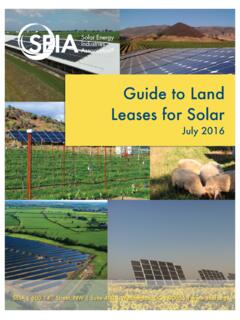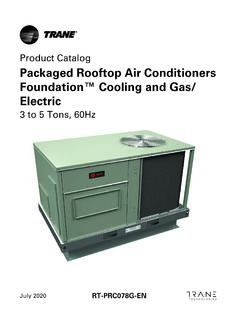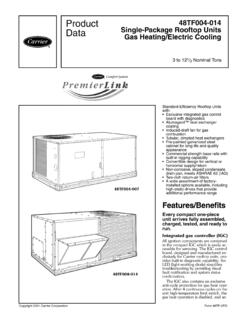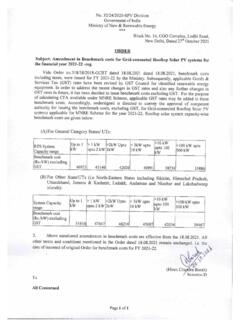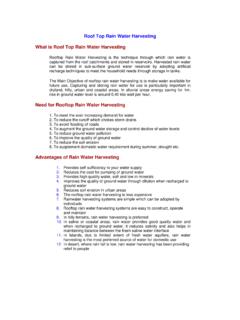Transcription of ASCE 7-16: Changes to Wind Calculations for Rooftop Solar
1 ASCE 7-16: Changes to Wind Calculations for Rooftop Solar Joe Cain, Chair, SEIA Codes & Standards Working Group David Banks, PhD, Principal Cermak Peterka Petersen (CPP) Agenda Market Trends Current Practice General Changes to ASCE 7-16 Solar -specific Changes to ASCE Mitigations in SEAOC PV2 update ASCE 7-16: Changes to Wind Calculations October 14, 2016 2016 Solar Energy Industries Association 2 Residential Market Trends 2010 to 2016 July 11, 2017 2016 Solar Energy Industries Association 3 Calculation of Wind Pressure: ASCE 7-10 and ICC-ES AC 428 Determine design wind speed and calculate design wind pressures using ASCE 7-10 ICC Evaluation Services Acceptance Criteria AC 428: Acceptance Criteria for Modular Framing Systems Used To Support Photovoltaic (PV) Panels AC 428 is required to obtain an ICC-ES Evaluation Report; it is also useful as voluntary guidance AC 428 allows internal pressure set equal to zero (within constraints) in Components & Cladding method In future ASCE 7-16, there will be a calculation method specific to flush mounted PV systems on sloping pitched roofs October 14, 2016 2016 Solar Energy Industries Association 4 ICC Acceptance Criteria AC 428 Components & Cladding method Internal pressure shall be set equal to zero Physical constraints are needed for method to be valid Pressure equalization is dependent on gaps between modules October 14, 2016 2016 Solar Energy Industries Association 5 ASCE 7-10 with ICC-ES AC 428 Criteria Physical constraints of AC 428 wind method.
2 Required 10 inch minimum distance from roof edge or ridge Height above roof between 2 inches and 10 inches Minimum gap of inch between adjacent rows of panels In earlier version of AC 428, minimum gap was inch October 14, 2016 2016 Solar Energy Industries Association 6 Don t forget to consider: Roof edge zones, which are changing in ASCE 7-16 Fire setbacks, which are changing (for the better) in 2018 IFC & IRC ASCE 7-16 Wind Speed Maps Revised (again) Risk Category II Mean Recurrence Interval (MRI) 700 years) ASCE 7-16 wind speed maps show contour lines in Western states 2016 Solar Energy Industries Association 7 October 14, 2016 C&C Roof Zones: ASCE 7-10 to 7-16 ASCE 7-16 Figure ASCE 7-10 Figure October 14, 2016 2016 Solar Energy Industries Association 8 Development of Corner & Edge Roof Zones October 14, 2016 2016 Solar Energy Industries Association 9 ASCE 7-16 Roof Zones ASCE 7-10 Roof Zones Roof GCp Coefficients: ASCE 7-10 to 7-16 ASCE 7-16 Figure ASCE 7-10 Figure October 14, 2016 2016 Solar Energy Industries Association 10 University of Western Ontario.
3 Stenabaugh Experiments were conducted in UWO boundary layer wind tunnel Two primary areas of investigation Height of PV system above roof Pressure equalization from various gaps between PV panels 2016 Solar Energy Industries Association 11 October 14, 2016 University of Western Ontario - Stenabaugh 2016 Solar Energy Industries Association 12 October 14, 2016 ASCE 7-16 with Associated Criteria 2016 Solar Energy Industries Association 13 Physical constraints of ASCE 7-16 method: Required minimum distance from roof edge or ridge 2h2 Height above roof between 2 inches and 10 inches Minimum gap of inch between all panels October 14, 2016 DRAFT ASCE 7-16 Section Basic form of Equation is very familiar Velocity pressure qh times pressure coefficient GCp New coefficients gE and ga are Solar -specific for flush mounts installed parallel to roof 2016 Solar Energy Industries Association 14 October 14, 2016 Zone 1: ASCE 7-16 GCp Pressure Coefficients 2016 Solar Energy Industries Association 15 October 14, 2016 Zone 1: Wind Pressure Equalization Factor 2016 Solar Energy Industries Association 16 October 14, 2016 Zone 1: Add ASCE 7-16 CA Wind Speeds 2016 Solar Energy Industries Association 17 October 14, 2016 Zone 1.
4 Closer to Roof, with PV2-2016 Equalization 2016 Solar Energy Industries Association 18 October 14, 2016 DRAFT Update to SEAOC PV2 Wind Paper Original SEAOC PV 2 wind paper was published in October 2012 Dr. David Banks of CPP Wind is primary author of PV2 update PV2 paper is updated to all requirements of ASCE 7-16 Updated PV2 is expected to be published by the end of 2016 ASCE 7-16 intended to be referenced in the 2018 IBC, and in effect by January 1, 2020 in most states 2016 Solar Energy Industries Association 19 October 14, 2016 ASCE 7-16: Exploring the Edge Factor, gE Edge Factor gE ( gamma E ) is a direct, linear multiplier to the wind pressure The value of gE is either or In ASCE 7-16, panels within Lp from end of row are exposed Result is three rows or fewer are 100% edge 2016 Solar Energy Industries Association 20 October 14, 2016 Mitigation for gE in (DRAFT) SEAOC PV2 Update 2016 Solar Energy Industries Association 21 Flush mount only October 14, 2016 Likely to be 2*h2 from array edge in final PV2-2016 ASCE 7-16.
5 PV Pressure Equalization Factor, ga Equalization Factor ga is a direct multiplier to wind pressure Wind pressure is reduced for gaps between panels John Wolfe public comment was disapproved by the ASCE Wind Subcommittee 2016 Solar Energy Industries Association 22 October 14, 2016 Mitigation for ga in DRAFT SEAOC PV2 Update SEAOC PV2 update will include more options for pressure equalization Options are height of PV system above roof and gaps between modules This alternative method rewards designs that consider optimization for wind Wind pressures can be reduced by 25 percent from worst-case basis of ASCE 7-16 2016 Solar Energy Industries Association 23 October 14, 2016 Contacts Codes & Standards: Joe Cain, Chair, SEIA Codes & Standards Working Group E-mail: Phone: +1-408-605-3934 David Banks, PhD, Principal, CPP Wind E-mail: Phone: +1-970-498-2350 2016 Solar Energy Industries Association 24 Questions?
6 October 14, 2016 Development of Corner & Edge Roof Zones October 14, 2016 2016 Solar Energy Industries Association 25 Development of Corner & Edge Roof Zones 2016 Solar Energy Industries Association 26 October 14, 2016




